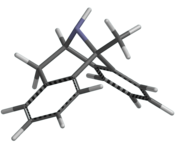Dizocilpine
 | |
 | |
| Clinical data | |
|---|---|
| Routes of administration | By mouth, IM |
| Identifiers | |
| |
JSmol) | |
| Melting point | 68.75 °C (155.75 °F) |
| |
| |
| | |
Dizocilpine (
Dizocilpine has also been found to act as a nicotinic acetylcholine receptor antagonist.[8][9][10] It has been shown to bind to and inhibit the serotonin and dopamine transporters as well.[11][12]
An animal model of schizophrenia
Dizocilpine has a great deal of potential to be used in research in creating
Possible future medical uses
The effects of dizocilpine at
Behavioural studies have shown that NMDA receptors are involved in the development of psychological dependence caused by chronic administration of morphine. Dizocilpine suppressed the morphine-induced rewarding effect. It is suggested that stimulating NR2B subunits of the NMDA receptor and its associated kinases in the nucleus accumbens leads to the rewarding effect caused by morphine. Inhibition of this receptor and its kinases in the nucleus accumbens by co-treatment with NMDA antagonists prevents morphine-associated psychological dependence.[21] An earlier study has shown that the prevention of morphine-associated psychological dependence was not due to state-dependency effects induced by dizocilpine[22] but rather reflect the impairment of learning that is caused by NMDA antagonists.[23] This is consistent with studies showing that dizocilpine potentiates the addictive potential of morphine and other drugs (see below).
As an antidepressant, positive results were found in
, a drug company, promptly dropped development of dizocilpine.Olney's lesions
Dizocilpine, along with other
Recreational use
This section possibly contains original research. (February 2015) |
This section needs additional citations for verification. (February 2015) |
Dizocilpine may be effective as a recreational drug. Little is known in this context about its effects, dosage, and risks. The high potency of dizocilpine makes its dosage more difficult to accurately control when compared to other similar drugs. As a result, the chances of
A multiple drug fatality involving dizocilpine,
Dizocilpine has been sold online as a Designer drug.[43]
See also
References
- ^ US Patent 4399141, Anderson P, Christy ME, Evans BE, "5-Alkyl or hydroxyalkyl substituted-10,11-imines & Anticonvulsant Use Thereof", issued 1983-08-16, assigned to Merck & Company Inc
- S2CID 5486568.
- PMID 2448800.
- S2CID 268615.
- S2CID 29029744.
- S2CID 27485569.
- PMID 9846639.
- PMID 1694895.
- S2CID 45243975.
- S2CID 54377970.
- S2CID 1419196.
- PMID 7881731.
- S2CID 25887719.
- S2CID 26794826.
- S2CID 22688722.
- S2CID 25943336.
- PMID 16256835.
- PMID 9337127.
- S2CID 45853861.
- PMID 3312511.
- PMID 15946694.
- S2CID 4029402.
- S2CID 4356601.
- S2CID 41078092.
- S2CID 30861122.
- S2CID 39020295. (Editorial)
- PMID 7969945.
- PMID 1674849.
- S2CID 12624754.
- PMID 3057216.
- ^ PMID 2660263.
- S2CID 24071513.
- S2CID 19052517.
- S2CID 20604534.
- S2CID 28368130.
- S2CID 24839154.
- PMID 8622141.
- S2CID 24305644.
- PMID 2181113.
- S2CID 30742891.
- PMID 8997600.
- PMID 12742697.
- ^ "foche - premium research chemicals". 2023-06-01. Archived from the original on 2023-06-01. Retrieved 2023-06-07.
Further reading
- Wong EH, Kemp JA, Priestley T, Knight AR, Woodruff GN, Iversen LL (September 1986). "The anticonvulsant MK-801 is a potent N-methyl-D-aspartate antagonist". Proc Natl Acad Sci USA. 83 (18): 7104–8. PMID 3529096.
original publications for MK-801:
- Clineschmidt, BV, Martin GE, Bunting PR (1982). "Anticonvulsant activity of (+)-5-methyl-10, 11-dihydro-5H-dibenzo[a,d]cycloheptene-5, 10-imine (MK-801), A substance with potent anticonvulsant, central sympathomimetic, and apparent anxiolytic properties". Drug Dev Res. 2 (2): 123–134. S2CID 221650650.
- Clineschmidt BV, Martin GE, Bunting PR, Papp NL (1982). "Central Sympathomimetic Activity of (+)-5-methyl-10, 11-dihydro-5H-dibenzo[a,d]cycloheptene-5, 10-imine (MK-801), a substance with potent anticonvulsant, central sympathomimetic, and apparent anxyiolytic Properties". Drug Dev Res. 2 (2): 135–145. S2CID 196746088.
- Clineschmidt BV, Williams M, Witowslowski JJ, Bunting PR, Risley EA, Totaro JT (1982). "Restoration of Shock-Suppressed Behavior by Treatment with (+)-5-methyl-10, 11-dihydro-5H-dibenzo[a,d]cycloheptene-5, 10-imine (MK-801), a substance with potent anticonvulsant, central sympathomimetic, and apparent anxiolytic properties". Drug Dev Res. 2 (2): 147–163. S2CID 143727405.
External links
- Erowid Dizocilpine experience vault—includes reports from users of Dizocilpine
